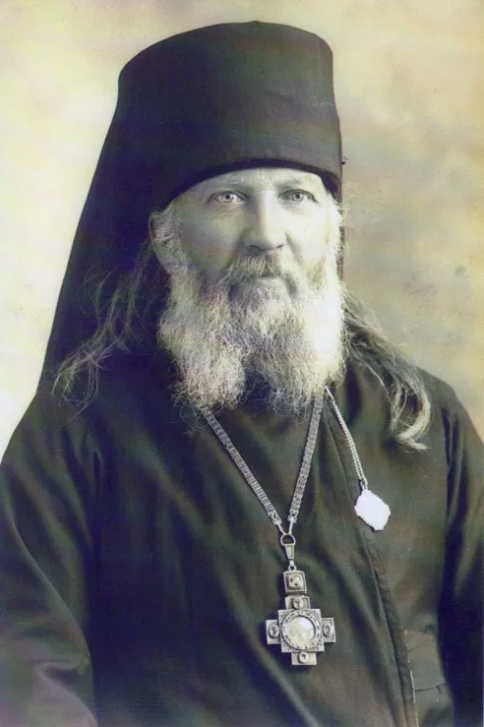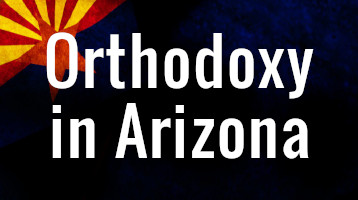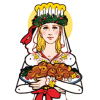
Brief life of Archbishop Ioasaph (Skorodumoff), founder of St. Vladimirs Church, Edmonton
from “The Orthodox Word”, March-April 1968
It was Novgorod the Great that nourished and formed the future hierarch-enlightener of Canada. Vanya (diminutive form of Ioann-John) Skorodumoff [in English, “Quick thinker”] was born on January 14, 1888, the son of a village priest. His mother died when he was six. At the age of ten his father brought him to Tikhvin, a town famous for its miraculous Icon of the Mother of God, and there he completed the seminary preparatory school, after which he entered Novgorod Seminary.
From his early years, asceticism entered the boy’s life. The Church-centered life of Imperial Russia, with its abundance of monasteries, convents, hermitages and sketes in towns, on lakes and in forests, the wonderworking icons, the hermits unknown to the world, the wanderers and pilgrims, the religious processions with many choruses singing and hells ringing–all this left a deep impression on the young ascetic, At first it was almost game, Vanya and his elder brother would go fishing and stay overnight somewhere outdoors, lost in the warm summer night, talking and reading about the great ascetics of old and the lives of saints. On the way hack they would perform a “podvig” [spiritual struggle or exploit]-carrying a pail of fish on one shoulder without changing for miles, all the way home. At times their shoulders would be bleeding, and although such “podvig” was discouraged at home by the elder sister, who was something of a mother to them, still the boys would be elated for having endured suffering. They also walked some distance barefoot on the snow, unseen by anyone…
In 1908, having brilliantly completed the Seminary course, he entered the St. Petersburg Theological Academy, where he became the devoted disciple of its saintly Rector, Theophan, later Bishop of Poltava. Vladika Theophan (Bystroff) was an intensely learned theologian and a great expert in the Jesus Prayer; to him even the fate of the dead was somewhat revealed. Under his influence the young Skorodumoff was properly introduced to the art of arts, which he apparently practiced well, since for the rest of his life he was constantly in a joyful state, as if experiencing joy like that of Pascha. His graduating thesis was on “Monasticism according to St. John Chrysostom,” and the Saint’s influence shaped the spiritual personality of the future archpastor for life. On this Saint’s day he was tonsured a monk, and 43 years later on the same day he died.
Not long before his graduation his Abba Theophan was transferred to Astrakhan, a large seaport at the mouth of the Volga River, and the faithful disciple, upon successfully graduating from the Academy, gathered all his meager means and undertook the trip down the Volga to his bishop. On the way his fears were quieted by a vision in a dream, which came true just as he had seen it. In monasticism he was given the name of the recently canonized St. Ioasaph of Belgorod.
At first he was sent to teach in a seminary in northern Russia, but soon he was transferred back to his Abba, now in Poltava, where he served as an army chaplain. After the end of the war he taught in Constantinople and at various seminaries in Yugoslavia. There he was known to serve Vespers and Matins daily, which he unfailingly continued to do for the rest of his long life.
A friend of his, a former strannik pilgrim who roamed many holy places of Old Russia, was now in Canada; he wrote from there that the schism of Metropolitan Platon in 1926 left no legitimate Orthodox clergy in Canada, yet the land was so reminiscent of Russia and was fertile for the seed of the word of God. “Do you want to come?” concluded the letter. “I do!” was the immediate response, even though he was quite aware of the hardships that this involved. It was only in 1930, however, that Archimandrite Ioasaph arrived in Montreal. In half a year he was made bishop for Canada. Metropolitan Anthony Khrapovitsky tonsured him in Belgrade on October 12, 1930. Upon handing him the archpastoral staff he warned him of the nature of the Christianity he would meet in America: “You are going to people who have long lived in an understanding of things that has nothing whatsoever to do with Christianity. Bring them the teaching of humility; accept this staff as a staff of benevolence and, blessing the people who now stand before you, think of the flock there, who already love you.”
And it was precisely the wisdom of humility (smirennomudrie in Slavonic) that taught him to be an exemplary missionary in the post Christian era and preserved him pure in heart. “In my life,” said he in his sermon upon being consecrated bishop, “two questions have especially occupied my attention. First: the exploration of the ways of God’s mercy. I observed God’s unutterable mercy first of all in richly-endowed nature, and explained it to myself that nature subordinates itself to inevitable natural laws. Then I began to observe human life; and even where free will was leaning towards evil, I always found God’s mercy. Then I decided to turn to that which is most sinful, most evil, and I turned to my inward life. It seemed that here there was no place for God’ s mercy because there was nothing good in it; but even here I discovered God’s mercy, and I remembered the words of the Psalmist:
Whither shall I go from Thy Spirit?
Or whither shall I flee from Thy presence?
If I ascend up into heaven, Thou art there;
If I make my bed in hell, behold, Thou art there.
Then I finally became convinced that the mercy of God towards man is limitless and boundless. The second question which I sought to solve was: will the Last Judgment be soon? Judging by signs in nature, by the moral state of humanity, and finally, by myself, I felt that the time was close, that one had to hasten to do the work of God and bring into reality the preaching of His Kingdom.”
Vladika was an unmercenary. He came to Canada almost penniless, lived and travelled entirely on the donations of his poor countrymen: at times when visiting his diocese he would hardly have enough to pay the fare to the next village parish. For the first ten years he endured not only poverty and cold, but also much sorrow thanks to the rivalry of various church jurisdictions which separated themselves from the One Holy Apostolic Orthodox Church. Metropolitan Platon, who had severed communion with the Synod of the Russian Orthodox Church Outside of Russia in 1926, died, and his successor, Metropolitan Theophilus, sought to remedy the schism created by his predecessor. The Metropolia, by majority concilliar decision, was thus accepted under the Synod of the Church Abroad in 1937. Bishop Ioasaph and the three other North American bishops of the Russian Church Abroad were placed under the administrative authority of the Metropolia. This unity was to be short lived, however, for just nine years later at the Cleveland Sobor, with four of the eight voting bishops opposing the motion, the Metropolia again severed all relations with the Church Abroad, recognizing that such an affiliation was incompatible with their desire for autocephaly under the Patriarch of Moscow, Alexey, appointed by Stalin. With Archbishop Vitaly, and Bishops Tikhon, Jerome, and Seraphim, Bishop Ioasaph staunchly opposed this foolhardy action, which blindly ignored the continued persecution of the Russian Church by the Soviet authority and the complicity of the Moscow Patriarchate in this bloodying of the Robe of Christ. In this way, there again emerged a division in the Canadian diocese, and Bishop Ioasaph found himself very isolated. Nevertheless, after ten years in Canada, this penniless yet cheerful bishop had overseen the establishment of a cathedral church in Edmonton with living quarters for several clergymen, forty parishes, a monastery at Whitefish Lake, and the Holy Protection Skete near Blufton.
After living for many years in Canada, just after recovering from a severe illness, Vladika was raised to the rank of archbishop and sent to Argentina. Here he soon became deeply loved by all. During his first visitation of his diocese, which included Paraguay as well, he visited a sick woman who had lain paralyzed in a hospital for a long time. She asked his prayers, to which he at once agreed, but he asked her whether she had faith in God and His ability to heal her. She said “yes.” Whereupon he prayed and gave his panagia to her to kiss, after doing which she was healed. The mother of Fr. V. Drobot had a severe toothache when Vladika visited them. As he was about to leave, he hit her with his fist right on the place of the aching teeth, saying, “That’s nothing, it will go away.” And at once the pain stopped.
Vladika’ s frail health and the’ hot climate of Argentina, especially after Canadian winters, drained his last strength, and he died a righteous death in 1955. He appeared in white vestments to many people in their dreams. There were cases also of Vladika’s rendering help from the other world. But one of the most striking testimonies of his holiness comes from the lips of the gardener gatekeeper, D. Carlos, of the English cemetery in Buenos Aires where Vladika Ioasaph is buried: “Once when it was already dusk, I noticed that in the chapel they had forgotten to turn off the electric light, and I went there. Before I had reached it, my attention was attracted by a powerful light at the left side of the chapel. But when I came closer, I saw that on the grave of your archpastor there was such an enormous light. At first I was frightened, but then I thought, what can the dead one do to me, and I decided to come closer. There was no chance that it could be a reflection from the vigil light on the grave, since the light was blue like the moonlight. It was something enormous. (Fue algo enorme.) I became terrified, although I am an atheist?’
Such was the earthly life of a true Orthodox enlightener of America
Sources:
The bulk of this text is copied from The Orthodox Word, March-April 1968.


